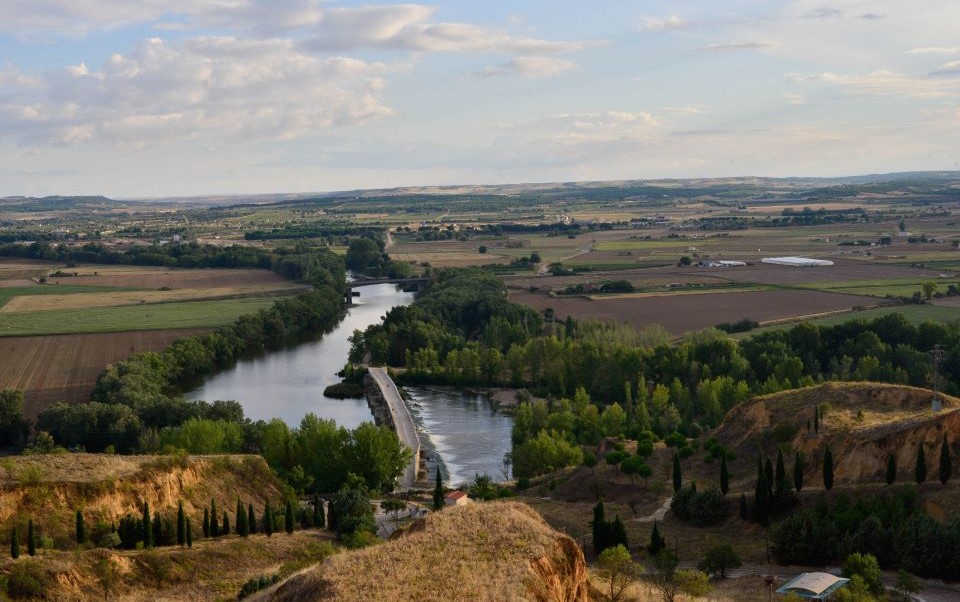Browse using the new Vinous website now. Launch →
Printed by, and for the sole use of . All rights reserved © 2015 Vinous Media
Reds From Toro: Old Vines and New Knowhow
BY JOAQUÍN HIDALGO | DECEMBER 05, 2023
In the town of Toro, there is a balcony overlooking the Duero River next to the Colegiata church, which has been a famous landmark since the 12th century. The town was built on a hill that rises about 300 feet above the river. As a result, the view from the top is quite impressive. Rolling plains stretch as far as the eye can see, with vineyards scattered here and there and a few patches of forest between the fields. Thick, dark clouds hung above during my visit in early September 2023, which were very welcome at that time of year, especially in the dry farming areas.
The city of Toro is situated atop a Hill and offers commanding views of the vineyard area. The Valdefinjas region, renowned for its old vines, is visible both in the foreground and background of the image.
At the end of summer, the swallows soar acrobatically around the local cliffs. Quiet afternoons in this old Castilla y León town are punctuated by the sounds emanating from the cafés and tapas bars. Many locals opt to sip on Toro reds, occasionally alternating with cold beers to beat the heat.
In the La Colegiata bar, just a few feet from the balcony, they advertise the house wine, “naturally made”. It’s a common sight in Toro – a small town with a population of 8,500 – where almost everyone has some connection to the wine industry. Wherever you go and whomever you talk to, they invariably have a vineyard, produce wine or their parents have a small patch of vineyard and make their own wine. Toro has a long history and is known for its production of reds, which is the primary focus here.
This corner of Castilla y León has a rich history in winemaking, dating back to pre-Roman times and especially during the reign of the Castilla monarchy. Toro wines were licensed for sale across Spain and earned a prominent place in Spanish winemaking folklore. That fame is associated with a distinctive yet consistent style of wine – a potent red made from Tempranillo grapes – which locals, and with no small measure of pride, call Tinto de Toro. This wine boasts intense tannins and high alcohol content, rounded out by a rich, energetic character.
During the 19th and 20th centuries, vineyards across Europe were severely affected by the phylloxera outbreak, leading to a drastic change in the style of wines produced. However, vines in Toro survived unscathed. This was thanks to sandy soils (with more gravel the closer you get to the Duero River) that make it difficult for the insect to latch to the roots of the plants. As a result, old vines are the rule. “Old vines, of course,” boasted Rubén Alfajeme from the Toro Regulatory Council. “They tend to be at least 100 years old, any more recent are considered young.”
The Vineyards of Toro
I spent a few days visiting several fascinating vineyards. In the Valdefinjas region, the technical team at Numanthia showed me some of their most treasured vines. At 8:30 in the morning, we walked across beach-like stretches of dry sand to the vineyards as the clouds that shed their rain the night before drifted over the hills. There, the vines are planted in the tresbolillo style – where one plant is placed in the center of an old hexagonal shape that can be plowed in three directions. These long-suffering, 150-year-old plants have protected their meager bunches of grapes from the rising sun. I knelt down to try a few of them and found they had thick skins and were sweet with mild acidity, intense and flavorful. “These ones are almost ready. We’ll harvest next week,” said Jesús Jiménez, the technical director at Numanthia. “That way, we’ll avoid any potential dehydration, which is a big danger in Toro.”
In another plot, some neighbors were already harvesting for their homemade wine. “They must be the Benilde Martín Garretas. They come from Barcelona about this time of year to pick their grapes. They’re over 80 years old and drive here every year to harvest and make their wine for the year,” says Jiménez. I was astounded. Apparently, this is common practice for the owners of the nearby rows of vines. The parcel is called Las Peñicas, was planted about 200 years ago and is considered one of the oldest in Toro.
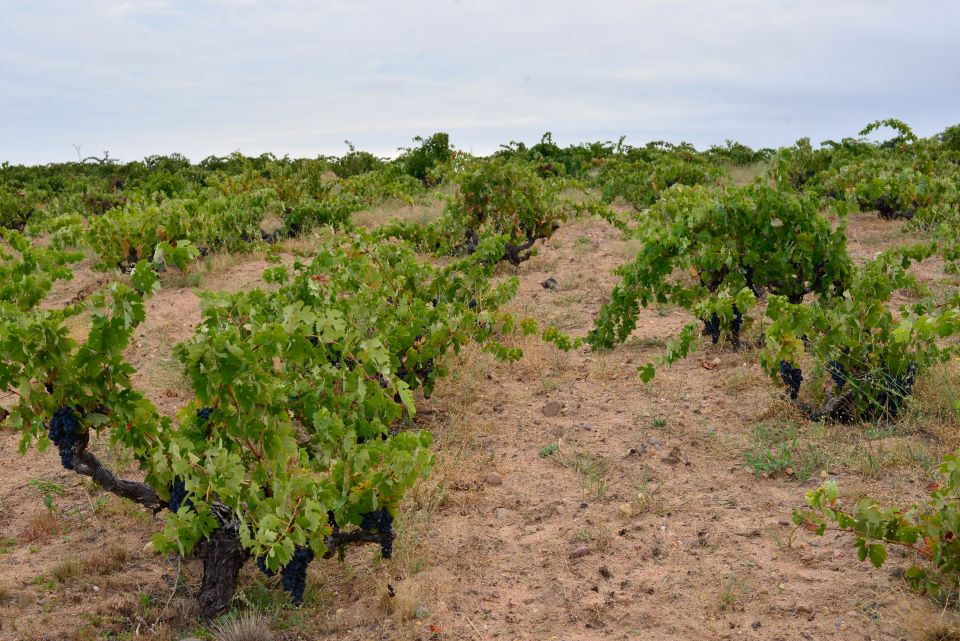
The region's soils are predominantly sandy, as seen in the photo. In these soils, Tinta de Toro (a Tempranillo phenotype with small clusters) survived the phylloxera and produces wines with energy and power, characterized by breadth and mature flavor.
At midday, with the September sun warming up the ground, I toured the San Román area, a valley that rises gently up from the Duero River to the plains, which is home to the Pintia y San Román winery, among others. Here, old vines sit alongside a few newer ones, some of which are irrigated. At the end of the day, with a storm framed by a rainbow on the horizon, I trod the consistently dry soils of La Hornija, which borders an old forest of oak and cork, to visit the El Legado de Horniz winery. Across the Duero River, there are vines planted in much stonier soils, and the white building of the Dominio de Bendito winery I’d visited the day before was just about visible.
Elegance or Power
Nothing about the Toro landscape suggests it might produce delicate wines; however, some winemakers manage to do so. The key, as is true of Tempranillo in general, is harvest time and gentle extraction methods. Marcos Eguren, who runs Teso La Monja, is well-versed in this area: “Everything here is open top, with very gentle pressing in the aqueous phase and slow fermentation.” His 2016 Teso La Monja is a good example of his expertise. But not the only one. In San Román, Eduardo García and his team achieved a similar result with a Bordeaux approach, subtly working the tannins, as can be seen in the 2020 Prima. In contrast to Ribera, the structure in Toro tends to be better defined by the soils and the ripeness the grapes achieve here. “The challenge for Toro is elegance,” García told me.
Of the 100+ wines I tasted from Toro, a DO comprising 5,400 hectares under vine and about 60 active wineries, only a few have prioritized elegance over power. For example, the 2020 Dominio del Bendito is at the alcoholic end of the scale, while the 2020 San Román and 2020 Alabaster lie on the other, with excellent balance and elegant tannins. In the middle, you’ll find reds like the 2020 Vatán, the 2020 Numanthia and the 2017 Gran Colegiata Original.
It’s almost like producers are playing two separate games entirely, as befits an increasingly polarized world. On the one hand, there are those who believe that Toro terroir is all about power, and they enhance that characteristic with 15 percent alcohol, tannic structure and hefty bodies, all fine-tuned by winemaking. Other producers strive for elegance, aiming to achieve balance, mild freshness and refined tannins. Both styles are possible in the sandpits of Toro; it’s an aesthetic, sensory preference.
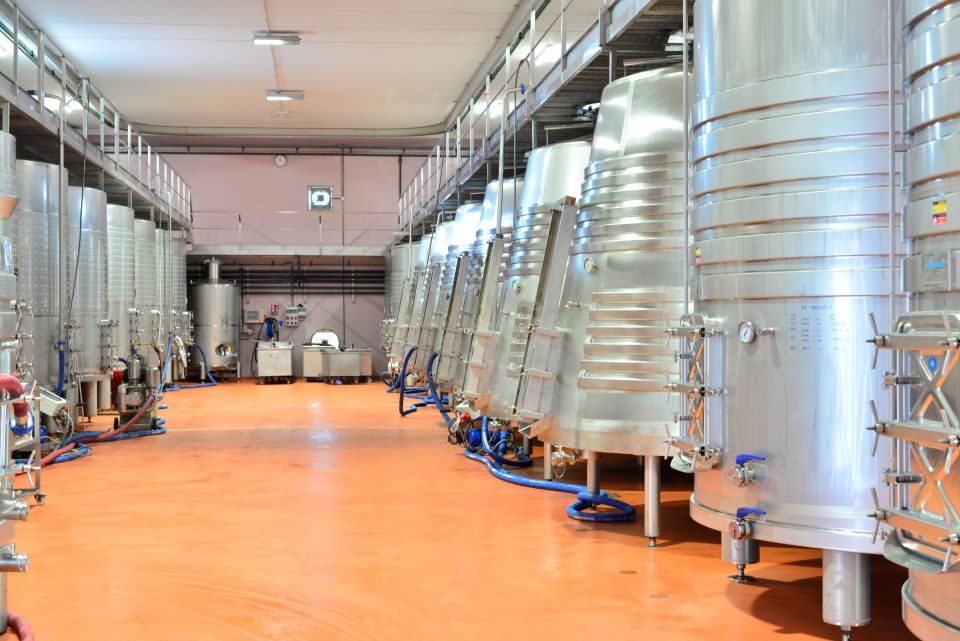
The fermentation facility at Bodega San Román, owned by the García family, is designed for red wine fermentations, utilizing conical tanks, as highlighted on the right.
The elegance movement has fewer proponents, but they’re also more dynamic. I envision more producers making the switch in the medium term. One of the obstacles is that the vineyards are not being renewed. In fact, they’re gradually shrinking across Toro. Everyone will work with their centennial vines for as long as possible, interpreting them differently. An illuminating example of the prevailing trend came with my tasting at Numanthia, where we did a few verticals: recent reds are comparatively more subtle than the balsamic, liqueur-like examples from the past. “We put all our effort into achieving that,” reports Jesus Jiménez, the technical director.
However, it’s notable how a small town set in the middle of the Castilian plains has managed to maintain its reputation over the centuries. It’s generally claimed around here that the reds Columbus brought on his first trip to the Americas were from Toro. Although it wasn’t until 1987 that the DO was officially inaugurated, it seems clear that the flavor profile has remained consistent over many, many years. To put it briefly, it is the essence of Toro. The red wines I tasted in early September this year attest to this.
© 2023, Vinous. No portion of this article may be copied, shared or re-distributed without prior consent from Vinous. Doing so is not only a violation of our copyright, but also threatens the survival of independent wine criticism.
You Might Also Enjoy
Ribera del Duero: A Shifting Frontier for Spanish Wine, Joaquín Hidalgo, November 2023
Atlantic Spain: It’s Always About the Weather…, Josh Raynolds, June 2021
Rioja: The Past Is Always Present, Josh Raynolds, April 2021
Tintos de Toro: viñas añosas con sabia nueva
JOAQUÍN HIDALGO | 05 DICIEMBRE 2023
En la ciudad de Toro hay un balcón sobre el Río Duero, justo al pie de la iglesia de la Colegiata, famosa desde el siglo XII. Como la ciudad fue construida sobre un monte que se levanta unos 100 metros sobre el nivel del río, la vista de ese balcón es imponente: la llanura ondulada se extiende hasta donde alcanza la vista, con viñedos aquí y allá, algunos parches de bosques recortados de campos de labranza y unas nubes densas y negras que, para el secano y, a mediados de septiembre de 2023 altura del año, son muy bienvenidas.
La ciudad de Toro se sitúa sobre una colina. Desde el balcón de la ciudad se domina la vista hacia el área de viñedos. La zona de Valdefinjas, famosa por sus viñas viejas, está al frente y a fondo en la imagen.
A finales del verano, las golondrinas hacen sus acrobacias en estos acantilados, mientras la parsimonia de las tardes en un antiguo pueblo de Castilla y León se demora en las mesas de los cafés y las barras de los bares entre tapa y tapa. La bebida en muchas mesas es el tinto de Toro, con algunas cañas heladas para atemperar el calor.
En el bar la Colegiata, a metros del balcón, se promociona el vino de la casa, “elaborado de forma natural”. No es ninguna excepción. Casi todas las personas que conocí en Toro –una ciudad pequeña de 8.500 habitantes– están vinculadas al vino: donde quiera que fuese y con quien quiera que hablase, tenía un viñedo o hacía vino o su padre cultivaba una parcela para hacer vino. Por eso, la larga historia de Toro en la producción de vinos tintos deja su impronta aquí.
Este rincón de Castilla y León remonta su vino a tiempos prerromanos, pero sobre todo al período atado a la corona de Castilla. Como el vino Toro tenía cédula para venderse en toda España, la región ganó fama más allá de sus muros gracias a un estilo de vino particular que, desde siempre, tuvo características definidas. Un tinto potente elaborado con Tempranillo –que llaman Tinta de Toro y no faltos de orgullo quieren diferenciarla– con taninos intensos y una graduación alcohólica elevada que define un estilo de riqueza y energía.
Durante los siglos XIX y XX, mientras la filoxera marcó un quiebre estilístico en las regiones de Europa, Toro se mantuvo incólume. Esa es la otra clave de este lugar: los suelos arenosos en su mayoría, y de gravas conforme uno se acerca al Duero, impiden que la filoxera alcance las raíces. En consecuencia, las viñas añosas son la norma. “Viñas viejas, claro –fanfarroneó de buen humor Rubén Alfajeme del Consejo Regulador Toro– aquí arrancan en los 100 años, menos las consideramos jóvenes”.
La Viña de Toro
Pasé dos días caminando viñas en esta región. En la zona de Valdefinjas, el equipo técnico de Numanthia me llevó a visitar algunos de esos viñedos-tesoros. Eran las 8:30 de la mañana y mientras unas nubes deshechas de tormenta de la noche manchaban con su sombra las colinas. Caminamos por la arena seca, igual que se camina en una playa. Allí, en viñedos en cabeza plantados al tresbolillo –un antiguo sistema con disposición hexagonal con una planta en el centro, que permite labrarlos en tres direcciones– las sufridas vides de 150 años protegían unos pocos racimos del sol ya creciente. Rodilla al piso, probé algunas de esas uvas: con un hollejo grueso, dulces y de moderada acidez, resultaban intensas y sabrosas. “Estas ya casi están. Cosecharemos la semana que viene –me dijo Jesús Jiménez, director técnico de Numanthia– así evitaremos toda posible deshidratación que es un flagelo en Toro”.
En otro paño, a unos 100 metros de donde estábamos, había unos vecinos cosechando ya para el vino del hogar. “Deben ser los Benilde Martín Garretas, vienen desde Barcelona en esta época para cosechar su parcela. Tienen más de ochenta años y todos los años manejan hasta aquí para podar y para elaborar el vino del año”, dice Jiménez. La historia me pareció alucinante, aunque es más frecuente de lo que uno imagina. La parcela se llama Las Peñicas, tiene unos 200 años y está considerada entre las más viejas de Toro.
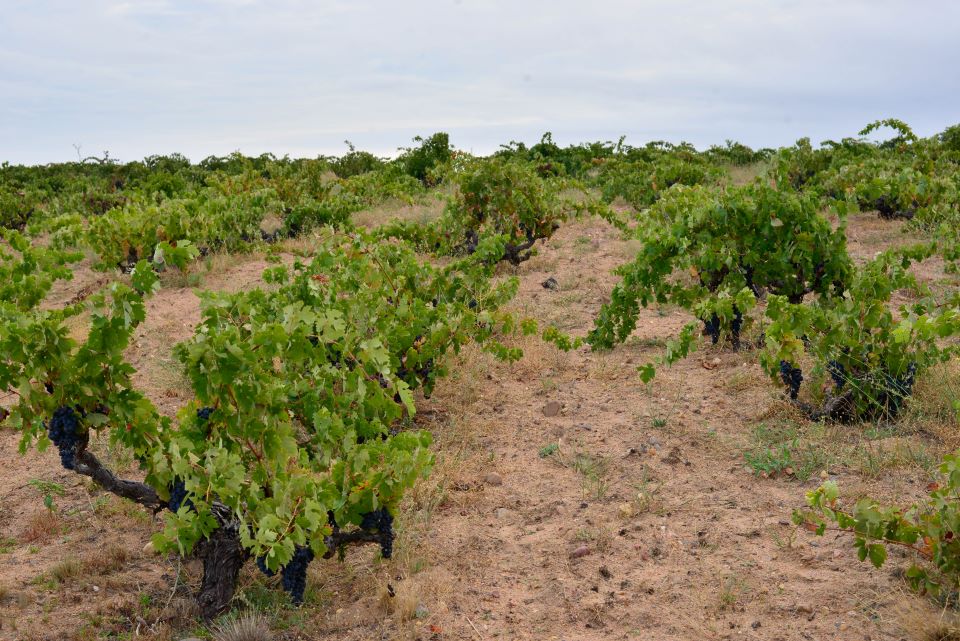
Los suelos de la región son mayoritariamente de arena, como los de la foto. En ellos, la Tinta de Toro (un fenotipo de Tempranillo con racimo pequeño) sobrevivió a la filoxera y ofrece vinos de energía y potencia, anchos y de sabor maduro.
Para el mediodía, ya con el sol de septiembre calentando los suelos, recorrí la zona de San Román, un valle que asciende suave desde el Duero hacia la planicie, donde está la bodega Pintia y San Román, por ejemplo. Aquí conviven viñas viejas con unas pocas nuevas, estas últimas con riego. A última hora, ese día, ya con otra tormenta declarada y bajo un arcoíris tan amplio que corría de punta a punta la llanura, caminé por el suelo siempre seco de La Hornija, en el linde del viejo bosque de robles y alcornoques, de la bodega El Legado de Orniz. Enfrente y al otro día del Duero, crecía la viña en vaso sobre suelos pedregosos. Podía distinguir el edificio blanco y enterrado de Dominio de Bendito que había visitado el día anterior.
Elegancia o potencia
Nada en el paisaje de Toro permite pensar en vinos delicados. Y sin embargo, algunos llegan a ese punto. El truco, como pasa con los Tempranillos en general, es el punto de vendimia y la extracción suave. De eso sabe mucho Marcos Eguren, al frente de Teso La Monja: “nosotros usamos todo open top, con pisoneos muy suaves en fase acuosa y llevamos la fermentación a ritmo lento”, me dijo. Su Teso La Mona 2016 es una buena muestra de esa maestría. Pero no es el único. En San Román, Eduardo García y su equipo, consiguen un plan similar con una fórmula bordelesa, sólo que trabajando con sutileza los taninos como demuestra Prima 2020. A diferencia de Ribera, la estructura de Toro es más marcada, por los suelos y la madurez que alcanza aquí la uva. “El desafío de Toro es la elegancia”, me dijo García.
De los más de 100 vinos que caté de Toro, una DO con 5.400 hectáreas plantadas y unas 60 bodegas activas, sólo una minoría redondea el estilo hacia una idea de elegancia con potencia. Si Dominio del Bendito 2020, por ejemplo, es el extremo más etílico de esa línea, San Román 2020 y Alabaster 2020 van en el otro extremo, hacia el balance y la elegancia de los taninos. En el medio quedan tintos como Vatán 2020, Numanthia 2020 y Gran Colegiata Original 2017.
Pareciera que entre los productores se juegan dos partidos distintos, igual que en un mundo que se polariza cada vez más. Un partido sostiene que el terroir de Toro es potencia, y subraya ese carácter llevando los vinos a 15 grados, con estructuras tánicas y cierta enjundia, y practican una enología a esa medida. Y otro partido, el de la elegancia, que pugna por un balance comedido, con frescuras moderadas y taninos finos, donde el cuidado en la extracción morigera el efecto del terroir. Los dos son posibles en los arenales de Toro. Son elecciones estéticas. Y de paladar.
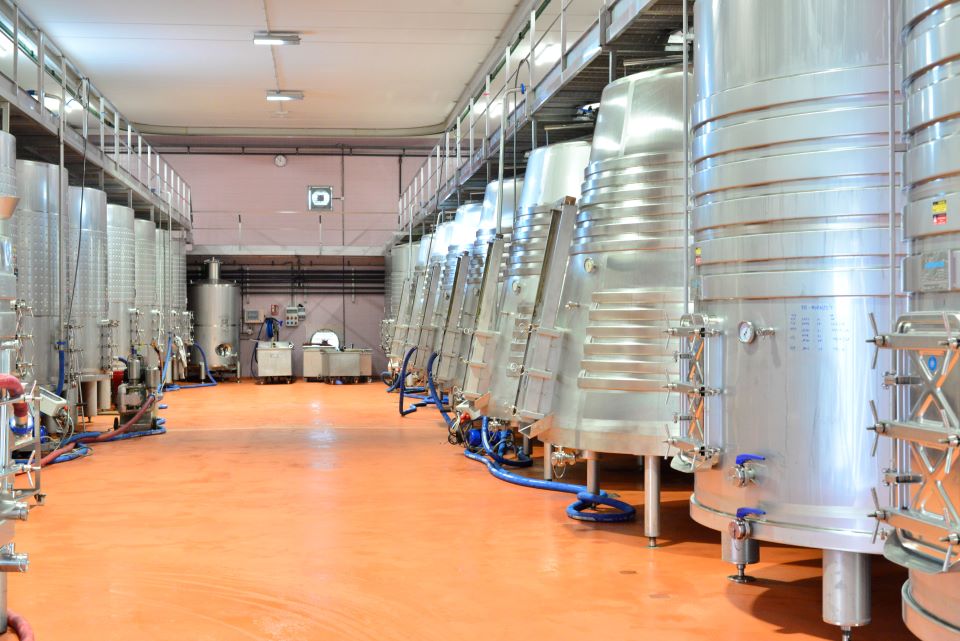
La nave de fermentación de Bodega San Román, perteneciente a la familia García, está pensada para fermentaciones de tintos, para los que usan tanques troncocónicos como los que destacan a la derecha.
El partido de la elegancia es el menos numeroso, pero al mismo tiempo el más dinámico. Imagino que en el mediano plazo habrá otros productores sumándose a esa idea. El truco, en todo caso, es que la renovación de las plantaciones va en vía muerta. De hecho, en materia de viñas Toro se achica lentamente. Todos trabajarán con las uvas centenarias durante el tiempo que sea posible para interpretarlas en uno u otro sentido. Si para muestras basta un botón, como se dice regularmente, en la cata de Numanthia, donde hicimos algunas verticales de sus vinos, está la semilla: comparados, los tintos de hoy ofrecen más matices que los balsámicos y licorosos del pasado. “Hemos hecho todo lo posible por conseguirlo”, sentencia Jiménez, director técnico de la casa.
Es notable, sin embargo, como un pueblo pequeño enclavado en mitad de la llanura castellana ha conseguido sostener su nombre a lo largo de los siglos. Si los tintos que llevó Colón en su primer viaje fueron los de Toro, según afirman en la región, y la DO fue establecida tan tardíamente como en 1987, al menos una cosa es segura: el perfil gustativo parece ser la clave. Carácter toresano, para decirlo en pocas palabras. Los tintos que caté allí a comienzos de septiembre de este año dan cuenta de ello.
© 2023, Vinous. Ninguna parte de este artículo puede ser copiada, compartida o redistribuida sin el consentimiento previo de Vinous. Si se incurriese en ello, no solo se viola nuestro copyright, sino que también se amenaza la supervivencia de la crítica independiente de vinos.
También Podrías Disfrutar
Ribera del Duero: una frontera en movimiento para los vinos de España, Joaquín Hidalgo, noviembre 2023
Atlantic Spain: It’s Always About the Weather…, Josh Raynolds, junio 2021
Rioja: The Past Is Always Present, Josh Raynolds, abril 2021
Show all the wines (sorted by score)
- Alvar de Dios
- Bodega Carmen Rodriguez Méndez
- Bodega Elias Mora
- Bodega Numanthia
- Bodegas Covitoro
- Bodegas Diez Gomez
- Bodegas Fariña
- Bodegas Francisco Casas
- Bodegas Frutos Villar
- Bodegas Gil Luna
- Bodegas Mazas
- Bodegas Sobreño
- Bodegas Torreduero
- Bodegas Vatan
- Bodegas Vega Sauco
- Bodegas y Viñedos Maires
- Bodega Viñaguareña
- Campo de Toro
- Campo Elíseo
- César Príncipe
- Coral Duero
- Cuatro Mil Cepas
- Dominio del Bendito
- Estancia Piedra
- Finca Volvoreta
- Garcia Carrion
- Hacienda Tintaurus
- Iturria
- Legado de Orniz
- Les Astronautes
- Moises Gran Vino
- Monte La Reina
- Pagos del Rey
- Pintia
- Quinta de La Quietud
- San Román Bodegas y Vinedos
- Teso La Monja
- Valbusenda
- Viñedos Alonso del Yerro
- Vocarraje


